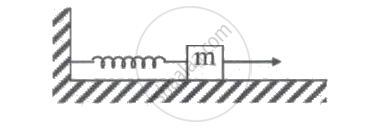Advertisements
Advertisements
Question
Solve the following problem.
A truck of mass 5 ton is travelling on a horizontal road with 36 km hr-1, stops on traveling 1 km after its engine fails suddenly. What fraction of its weight is the frictional force exerted by the road? If we assume that the story repeats for a car of mass 1 ton i.e., car moving at the same speed stops at a similar distance, how much will the fraction be?
Solution
Given:
mtruck = 5 ton = 5000 kg,
mcar = 1 ton = 1000 kg,
u = 36 km/hr = 10 m/s,
v = 0 m/s, s = 1 km = 1000m
To find: Ratio of the force of friction to the weight of the vehicle
Formulae:
i. v2 = u2 + 2as
ii. F = ma
Calculation:
From formula (i),
2 × atruck × s = v2 - u2
∴ 2 × atruck × 1000 = 02 - 102
∴ 2000atruck = - 100
∴ atruck = - 0.05 m/s2
Negative sign indicates that velocity is decreasing
From formula (ii),
Ftruck = mtruck × atruck
= 5000 × 0.05
= 250 N
∴ `"F"_"truck"/"weight"_"truck" = 250/(5000 xx 10) = 1/200`
From formula (i),
2 × acar × s = v2 - u2
∴ 2 × acar × 1000 = 02 - 102
∴ 2000 acar = - 100
∴ acar = - 0.05 m/s2
From formula (ii),
F = mcar acar = 1000 × 0.05 = 50 N
∴ `"F"_"car"/"weight"_"car" = 50/(1000 xx 10) = 1/200`
The frictional force acting on both the truck and the car is `1/200` of their weight.
APPEARS IN
RELATED QUESTIONS
Take 5 examples from your surroundings and give an explanation based on Newton's laws of motion.
Answer the following question.
In real life, objects never travel with uniform velocity, even on a horizontal surface, unless something is done? Why is it so? What is to be done?
For the study of any kind of motion, we never use Newton’s first law of motion directly. Why should it be studied?
Answer the following question.
You are inside a closed capsule from where you are not able to see anything about the outside world. Suddenly you feel that you are pushed towards your right. Can you explain the possible cause (s)? Is it a feeling or a reality? Give at least one more situation like this.
A batsman hits a ball of mass 0.2 kg straight towards the bowler without changing its initial speed of 6 m/s. What is the impulse imparted to the ball?
N number of balls of mass m kg moving along positive direction of X-axis, strike a wall per second and return elastically. The velocity of each ball is u m/s. The force exerted on the wall by the balls in newton, is ______.
Three blocks with masses m, 3m and 6m are connected by strings, as shown in the figure. After an upward force F is applied on block m, the masses move upward at constant speed v. What is the net force on the block of mass 3 m? (g is the acceleration due to gravity)
A particle moves in the x-y plane under the action of a force `vec"F"` such that the value of its linear momentum `(vec"p")` at any time t is Px = 2 cos t, py = 2 sin t. The angle `theta` between `vec"F"` and `vec"P"` at a given time twill be ____________.
A light string passing over a smooth light pulley connects two block of masses m1 and m2 (vertically). If the acceleration of the system is (3g/7), then the ratio of masses is ____________.
A block of mass m, lying on a smooth horizontal surface, is attached to a spring (of negligible mass) of spring constant k. The other end of the spring is fixed, as shown in the figure. The block is initially at rest in its equilibrium position. If now the block is pulled with a constant force F, the maximum speed of the block is: ____________.

A ball kept at 20 m height falls freely in downward direction vertically and hits the ground. The coefficient of restitution is 0.4. After the first rebound, the upward velocity is g = 10 m/s2 ?
A nucleus of rest splits into two nuclear parts having radii in the ratio 1 : 2. Their velocities are in the ratio.
